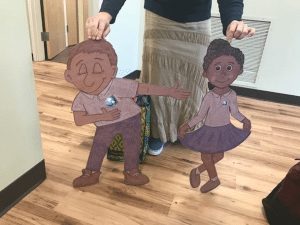Handwriting the Montessori Way

Kids in Montessori Daycare learn to write their letters in a unique way. Maria Montessori used her intuitive observations of children to devise a method of teaching handwriting that was tailored to their specific patterns of development. And, like many aspects of Montessori education, learning to form letters follows a very different pattern than what we see in traditional schools. Here is how we apply handwriting the Montessori way!
Handwriting mastery follows this basic progression:
- Works to strengthen the small muscles of the hand
- Works to practice proper pencil grip
- A Moveable Alphabet to “write” with
- Metal Insets to perfect pencil control
- Sandpaper Letters to mentally instill proper letter formation
Strengthening the Small Muscles
Handwriting begins with activities that have nothing to do with the alphabet. Before a child can attempt to form the letter A, he must develop the small muscles in his fingers. Fine motor skills are partially developmental–before a certain age a child simply cannot wield a pencil properly–but strengthening the small muscles can begin quite early.
As soon as an infant starts using the pincer grasp (picking up and manipulating small objects between the thumb and forefinger), he can begin working with simple knobbed puzzles, playing with playdoh, and stacking blocks. All of this will strengthen the small muscles in his fingers.
Pencil Grip Preparation
Sandpaper Letters
Dr. Montessori knew that young children learn through concrete means, so she designed the sandpaper letters as a tactile way to introduce letter formation to little ones.
The sandpaper letters are used initially as a means to teach letter sounds, creating a mental association between a letter’s sound and its shape. Later, preschoolers will trace these textured letters with two fingers and then attempt to repeat the shapes with a pencil in hand. But before they get there, they’ll use an alternative way to “write”: the Moveable Alphabet.
Moveable Alphabet
Dr. Montessori realized that children could understand how to string symbols that represent sounds (i.e. letters) together to form words long before their fine motor skills allowed them to write comfortably or legibly. So she developed the moveable alphabet–a set of small wooden letters–with which they could form words, sentences, and even stories.
Working with the moveable alphabet allows young kids to practice writing as communication as they continue to develop handwriting readiness.
Metal Insets
When preschoolers demonstrate improved pencil control, it’s time for them to begin forming the shapes and lines necessary to write letters. But like all Montessori works, this is done methodically. Kids trace inside of a set of metal insets to develop their pre-writing strokes. As they master tracing within a circle, they move on to the other shapes, the square, rectangle, and triangle, and the rounds: the oval, ellipse, square triangle, and quatrefoil. Next, they trace around the outside of all of these shapes.
Handwriting With Supportive Tools
Eventually, children will be ready to write freehand, with a pencil. At the start of this phase, tools such as the sandpaper letters and the moveable alphabet may be used for reference.
For many children, this will not happen during the preschool years. Handwriting is mastered at different ages for different kids. The important thing is that it is mastered, and that requires the proper foundations offered in the Montessori classroom.


